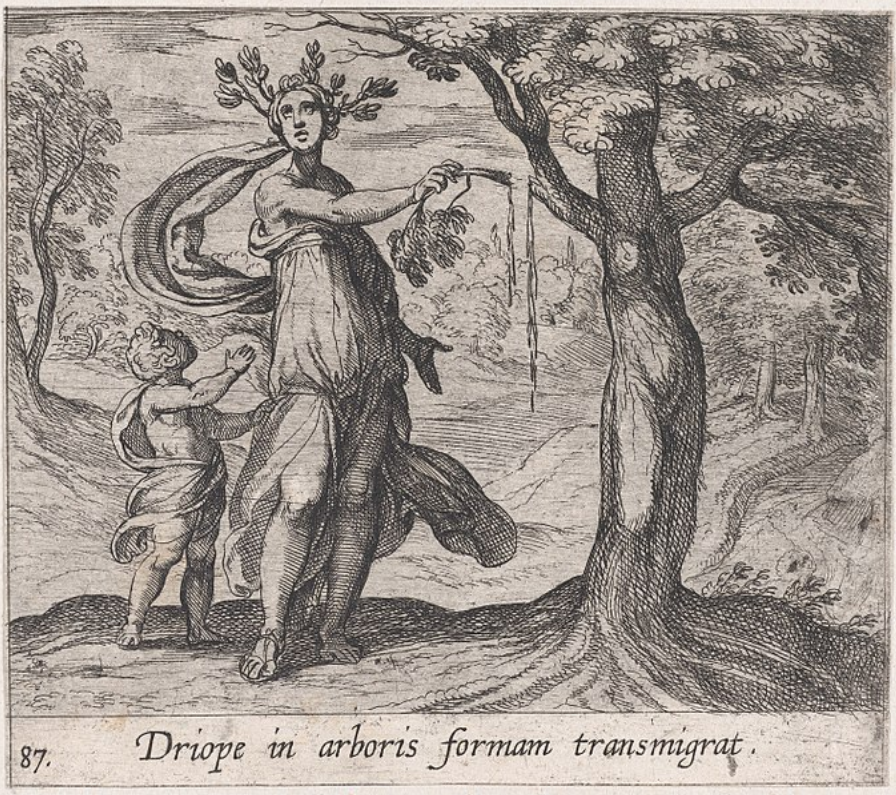Review: The Overstory
Dryope Changed into a Lotus Tree (Driope in arboris formam transmigrat), from Ovid's 'Metamorphoses', print, Antonio Tempesta
The Overstory follows nine protagonists who all fall in love with trees, each in different ways. Some love trees and nature through activism, art, or even seemingly supernatural mysticism.
Dr. Patricia Westerford is my favorite of them all, as she falls in love with trees by learning their myths. Patricia’s father is an arborist from southern Ohio, a mentor whom she eventually surpasses in her life as a professional dendrologist. When she turns 14, she receives a translation of Ovid’s Metamorphoses, and trees become holy.
Upon reading Ovid’s opening invocation, “she’s back where acorns are a step away from faces and pine cones compose the bodies of angels.”
“Let me sing to you now, about how people turn into other things.”
What she reads in Metamorphoses are projections of narrative onto features of the natural world, which in turn enrich her own view of nature–myths. Trees are no longer simply biological subjects for Patricia. They are characters whose stories have been written for millions of years since the first lichen grew on Gaia’s skin. Patricia’s own father exemplifies this when he explains the name of the beech tree, and how people write their own stories onto them.
“‘If you see a trunk carved full of letters, it’s a beech. People can’t help writing all over that smooth gray surface. God love ‘em. They want to watch their lettered hearts growing bigger, year after year. Fond lovers, cruel as their flame, cut in these trees their mistress’ name. Little, alas, they know or heed how far these beauties hers exceed!’” He tells her how the word beech becomes the word book, in language after language. How book branched up out of beech roots, way back in the parent tongue. How beech bark played host to the earliest Sanskrit letters. Patty pictures their tiny seed growing up to be covered with words.”
Patricia’s father here describes a beech with layman's knowledge (“If you see a trunk carved full of letters, it’s a beech.”), quotes the third stanza of Andrew Marvell’s poem “The Garden” (itself full of Classical allusion), and finally enriches the name of the tree itself by explaining its name. Powers uses both Patricia and her father to illustrate how people can use something so ancient and human–namely myth and story-telling–to explain how nature and humanity constantly influence each other.
This web of influence is endemic within The Overstory. For Neelay Mehta, another protagonist, the trees of Stanford’s campus are muses to inspire video games which explore human consumption of the environment. For Olivia Vandergriff, a redwood tree becomes a spirit which speaks to her from within and inspires her to engage in ecological activism. One may read Ovid as if he himself were a character in Powers’ novel, as if the cyprus was telling its own myth to him, and from him to Patricia.
This is one reason why I love The Overstory. The human protagonists are not really in closed interactions with each other as humans are in most novels, but in a web alongside trees. Trees are not simply objects to be used as motifs within The Overstory. Trees are characters unto themselves, interacting and changing people into different things, whether that be by inspiring Patricia through Ovid or by mystically communicating with a character, like Olivia.
In a way, Ovid doesn’t simply play the role of enriching Patricia’s perception of nature in The Overstory as some faraway, ancient classical author. Ovid himself becomes a human mouthpiece through which trees speak, as the cyprus, the myrtle, the oak and the linden become his muses. Trees in The Overstory demand our attention just as much as human protagonists do.
Powers’ use of Ovid in illustrating his characters’ transformations and the relations between people and trees is powerful, especially given Ovid’s own mythologization of trees within Metamorphoses. Ovid’s invocation and the subsequent influence of Metamorphoses on Patricia as a character made me engage with her on a deeper level than most of the other characters. There is much more I could say regarding Richard Powers’ use of myth in The Overstory, and I do think it would be worthwhile to study parts of his novel as practices in classical reception, especially within the realm of ecological literature.
Sources: Powers, Richard. The Overstory, 116–17. New York, NY: W. W. Norton Company, 2018.


